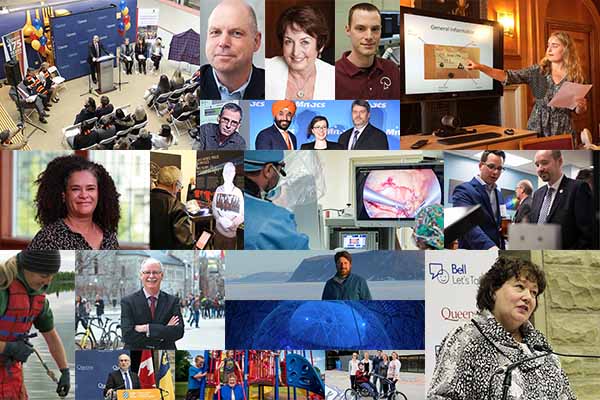YEAR IN REVIEW: An exciting year in research
December 21, 2017
Share

Queen’s University researchers continued to make breakthroughs, garner attention from around the world, and earn recognition for themselves, their teams, and the university in 2017.
Research prominence at the national and international level is a key driver for Queen’s and, as we near the end of the year, the Gazette takes a look at some of the work and people capturing our attention.
Funding and support highlights
The year got off to an excellent start when Bell Let's Talk and Queen’s renewed their commitment to mental health research. On Jan. 24, Bell Let’s Talk announced a $1 million gift to renew the Bell Canada Mental Health and Anti-Stigma Research Chair at Queen’s with Heather Stuart (Public Health) being reappointed to the position for another five-year term.
In February, Queen’s received a $5 million gift from geologist and entrepreneur Ross J. Beaty to support collaborative research and education in the field of freshwater resources. In recognition of the gift, the interdisciplinary research initiative, which will have a permanent space in the new Queen’s Innovation and Wellness Centre, has been renamed the Beaty Water Research Centre with Pascale Champagne (Civil Engineering) as director.
At the beginning of March, the Canadian Frailty Network, an internationally-recognized research network focused on improving health care for an aging population, received $23.9 million in renewal funding from the Government of Canada’s Networks of Centres of Excellence program, covering the next five years.
In early October, Queen’s witnessed the opening of a world-class cardiopulmonary research facility thanks to $7.7 million in funding from the Canada Foundation for Innovation and the Ontario Ministry of Research, Innovation and Science.
A week later a combined $4.8 million in funding from the CFI Innovation Fund was announced in support of continuing research into detecting dark matter as well as optical science.
Fellowships and Chairs
Each year, Queen’s faculty and researchers receive recognition for their work and dedication to pushing the boundaries of knowledge. Standing out this year was Queen’s National Scholar Norman Vorano, who received a Trudeau Fellowship for his work with Indigenous communities in the Canadian Arctic to record, understand, and share Inuit art history. An assistant professor in the Department of Art History and Art Conservation and curator of Indigenous art at the Agnes Etherington Art Centre, Dr. Vorano was one of five recipients of one of the most competitive awards available to humanities and social science scholars in Canada.
Queen’s researchers continued to be recognized by the Royal Society of Canada with Richard Bathurst (Civil Engineering), Anne Croy (Biomedical and Molecular Sciences), and Robert Morrison (English), being elected as fellows. Two mid-career faculty members – Katherine McKittrick and Karen Yeates – were named to the Royal Society of Canada’s (RSC) College of New Scholars, Artists and Scientists program.
When it comes to the Canada Research Chair (CRC) program, Queen’s continued to attract attention with a new chair being named while two others were renewed. In May, Cathleen Crudden (Chemistry) was named the new Tier 1 Canada Research Chair in Metal Organic Chemistry, while Peter Davies (Biomedical and Molecular Sciences) was named Tier 1 Canada Research Chair in Protein Engineering) and Mohammad Zulkernine (Computing) was named Tier 2 Canada Research Chair in Software Reliability and Security. In November, five researchers – Pascale Champagne (Civil Engineering), Will Kymlicka (Philosophy), Warren Mabee (Geography and Planning), Morten Nielsen (Economics), and R. Kerry Rowe (Civil Engineering) – had their CRCs renewed.
Prizes and Awards
Other recognition includes prizes and awards, and Queen’s researchers proved prolific once again this past year. While there are too many to list, some of the highlights for 2017 include: Professor Emerita Elizabeth Eisenhauer receiving the Exceptional Leadership in Cancer Research from the Canadian Cancer Research Alliance; John Rudan (Surgery) being inducted into the Canadian Academy of Health Sciences Fellowship; Andrew Pollard (Mechanical and Materials Engineering) and Christopher Pickles (Mining Engineering) being named named fellows of the Canadian Academy of Engineering. Internally, the Prizes for Excellence in Research, Queen’s highest research award, were given to Sam McKegney (English), Liying Cheng (Education), Cathleen Crudden (Chemistry), Pascale Champagne (Civil Engineering), and Denis O’Donnell (Medicine).
Queen’s students also were recognized this year for their research. Matthew Holden, currently pursuing a PhD at the School of Computing, became only the second Canadian to recieve a Link Foundation Fellowship. Another PhD student, Caitlin Miron, received the Mitacs PhD Award for Outstanding Innovation for her work in biochemistry.
Notable Developments
There also were a number of notable developments in the research portfolio at the university in 2017. In March, John Fisher was appointed Interim Vice-Principal (Research). Not long after, a renewal process was launched for the Strategic Research Plan to help guide the university over the next five years. Providing a boost for technology transfer at Queen’s was the establishment of the Office of Partnerships and Innovation with Jim Banting being appointed Assistant Vice-Principal (Partnerships and Innovation).
Finally, Queen’s joined as a founding member of The Conversation Canada , an exciting partnership combining the expertise of the university’s academics with the journalistic rigour of a professional editorial team to publish articles and opinion pieces that can be picked up by media outlets around the world. Over 40 Queen’s researchers have published pieces with the platform since the site’s launch in Spring 2017.
To learn more about research at Queen’s, visit the Queen’s research website.